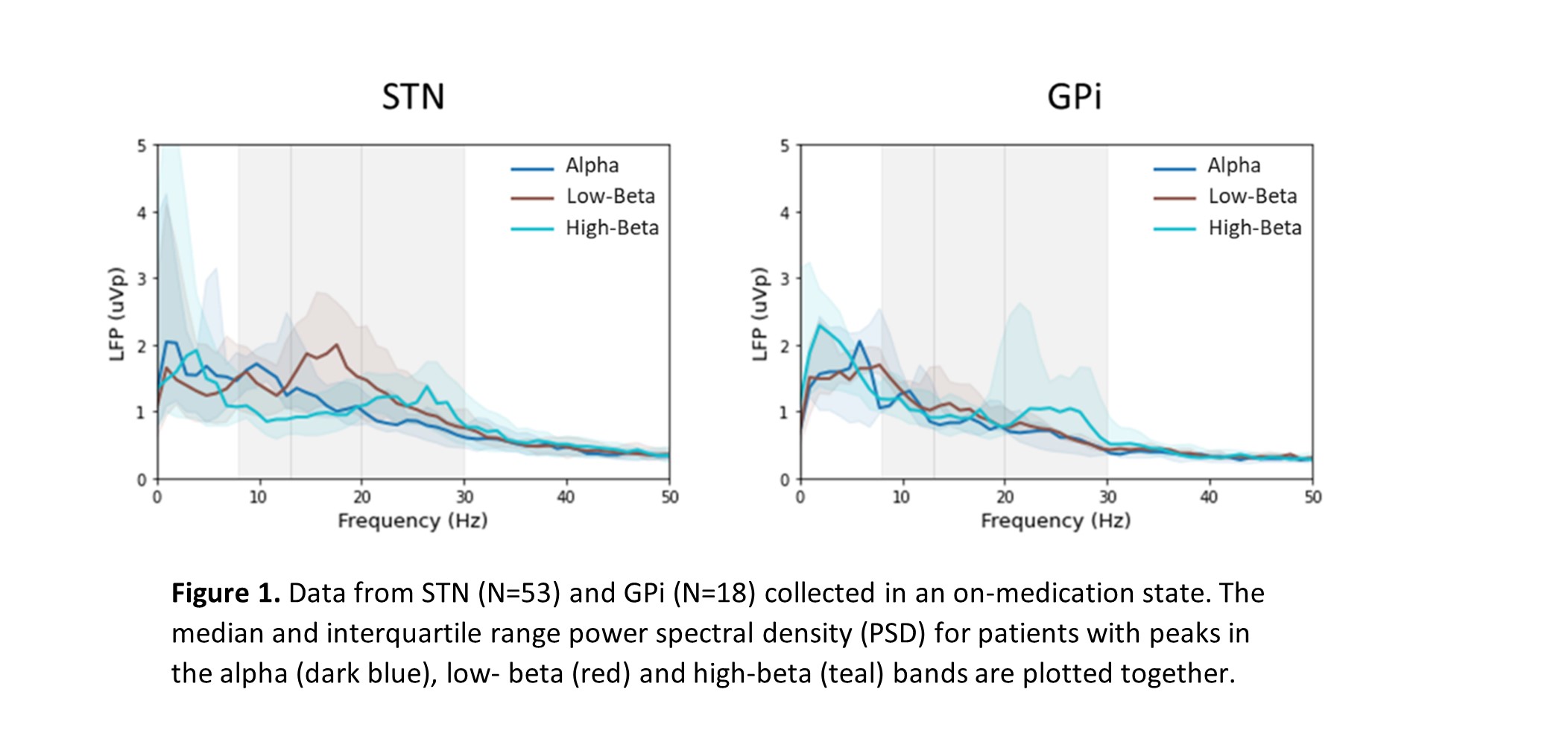Category: Parkinson's Disease: Neurophysiology
Objective: To describe enrollment sensing data from the Adaptive DBS Algorithm for Personalized Therapy in Parkinson’s Disease (ADAPT-PD) trial (NCT04547712).
Background: Local field potential (LFP) peaks in alpha and beta bands (8-30 Hz) are detectable in >90% of PD patients off-medication [1,2], suggesting that a possible useful adaptive DBS (aDBS) control signal is present in nearly all PD patients. However, less is understood about on-medication LFP signal detectability and frequency band distribution across different DBS brain targets.
Method: Enrollment data was extracted from the ADAPT-PD trial. Participants had DBS leads targeted to the globus pallidus interna (GPi) or subthalamic nucleus (STN) and connected to a commercial sensing implantable pulse generator. During the enrollment phase, LFP peaks were visually identified by clinicians during on- or off-medication states at the Enrollment visit (on medication) and LFP Screening visit (off medication). An automated peak detection algorithm was used to determine alpha, low-beta, and high-beta peak prevalence in the on-med state.
Results: Sixty-eight PD patients with bilateral STN DBS (51 STN and 17 GPi) were enrolled in the ADAPT-PD primary cohort (71% male, 62.2±8.4 years of age, 13.5±6.8 years disease duration, 45.7±14.9 UPDRS-III off med/off DBS). A clinician-identified LFP peak was present on- or off-medication in 84% of participants, corresponding to 40 patients with STN DBS and 17 patients with GPi DBS. On medication, LFP data were available for off-line analysis from 63 participants [N= 126 nuclei (STN = 94; GPi = 32)] in which an automated algorithm identified LFP peaks in 71 (56.3%) nuclei [Figure 1] and 45 (71.4%) patients. The algorithm identified LFP peaks in 53/94 STN and 18/32 GPi, with similar peak detection rates between the STN and GPi (56.8% and 56.3%, respectively). Across recordings in STN and GPi, automated algorithmic identified peaks fell within low-beta (32.4%), high-beta (43.7%) or alpha (23.9%) bands. For STN, peaks fell within low-beta (43.4%), high-beta (32.1%), alpha (24.5%); and for GPi, peaks fell within low-beta (44.4%), high-beta (44.4%), and alpha (11.1%).
Conclusion: Initial data from the ADAPT-PD enrollment phase demonstrate that LFP peaks are readily identified by clinicians or automated algorithms in the on dopaminergic state and do not substantially differ between STN or GPi.
References: Little S, Brown P. What brain signals are suitable for feedback control of deep brain stimulation in Parkinson’s disease? Ann N Y Acad Sci. 2012;1265:9-24. doi:10.1111/j.1749-6632.2012.06650.x
Darcy N, Lofredi R, Al-Fatly B, et al. Spectral and spatial distribution of subthalamic beta peak activity in Parkinson’s disease patients. Exp Neurol. June 2022:114150. doi:10.1016/j.expneurol.2022.114150
To cite this abstract in AMA style:
T. Herrington, B. Beudel, J. Ostrem, L. Almeida, A. Ramirez-Zamora, A. Fasano, T. Hassell, K. Mitchell, E. Moro, M. Gostkowski, N. Sarangmat, S. Stanslaski, L. Tonder, Y. Tan, R. Summers, A. Singer, N. Morelli, R. Raike, H. Bronte-Stewart. Enrollment phase sensing data from the Adaptive DBS Algorithm for Personalized Therapy in Parkinson’s Disease (ADAPT-PD) clinical trial [abstract]. Mov Disord. 2023; 38 (suppl 1). https://www.mdsabstracts.org/abstract/enrollment-phase-sensing-data-from-the-adaptive-dbs-algorithm-for-personalized-therapy-in-parkinsons-disease-adapt-pd-clinical-trial/. Accessed April 26, 2025.« Back to 2023 International Congress
MDS Abstracts - https://www.mdsabstracts.org/abstract/enrollment-phase-sensing-data-from-the-adaptive-dbs-algorithm-for-personalized-therapy-in-parkinsons-disease-adapt-pd-clinical-trial/

